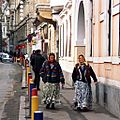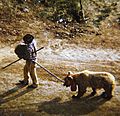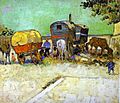Gypsy facts for kids
The word Gypsy is often used to describe the Romani people. The Romani are a group of people who originally came from India. Over many centuries, they traveled through Egypt and then moved into Europe. They are known for their rich culture and often lived in caravans, which are like homes on wheels.
It's important to know that calling someone a "Gypsy" can sometimes be seen as offensive. This is because the term has been used in negative ways in the past. Many Romani people prefer to be called "Romani" or by the name of their specific group.
Contents
Who Are the Romani People?
The Romani people are a diverse group with many different communities around the world. They share a common heritage but have developed unique cultures and languages depending on where they settled.
Romani Communities Around the World
Some well-known Romani groups include:
- The Sinti: These Romani people mostly live in central Europe.
- Roma in Turkey: Also known as Romanlar, they are a large Romani community in Turkey.
- Gitanos: These are Spanish Romani people who speak a language called Caló.
- "Travellers": These groups are mainly found in Great Britain, Ireland, and the United States.
"Gypsy" in Music and Arts
The word "Gypsy" has also been used in many creative works, including music, musicals, and stories.
Music Inspired by "Gypsy"
- The Gypsy Kings: This is a famous music group from the 1980s. They play a popular style of traditional flamenco music.
- Gypsy and the Haylocks: This was a reggae folk band from the 1970s. They were known for being one of the first bands to mix these two music styles.
- "Gypsy": This is the name of a song by the popular band Fleetwood Mac.
- "Gypsy": Another song with this title was released by The Moody Blues.
- Gypsy: A Musical Fable: This is a famous musical play. It was inspired by the life of a performer named Gypsy Rose Lee.
"Gypsy" Characters in Fiction
You might also find characters named Gypsy in different stories and shows:
- Gypsy: A robot character from the TV series Mystery Science Theater 3000.
- Gypsy: A fictional character who appears in DC Comics stories.
- Gypsy Moth: A fictional mutant character from Marvel Comics.
Other Uses of the Word "Gypsy"
The word "Gypsy" has been used in other ways too, sometimes for places, animals, or even objects.
Places and Things Called "Gypsy"
- Gypsy, West Virginia: This is a small place in the United States.
- Gypsy moth: This is a type of insect. It is known for eating the leaves off trees, which can cause a lot of damage.
- Gypsy (software): This was one of the first modern computer programs used to create documents.
- Winston "Gypsy" Peters: He is a politician and a singer from Trinidad and Tobago. He is known for his calypso music.
- Gypsy: This is the name of an elephant that was given to singer Michael Jackson by actress Elizabeth Taylor.
- A "gypsy" is also a part on a boat's windlass. This part helps to pull up the anchor chain.
Images for kids
-
Three Finnish Romani women in Helsinki, Finland, in 1930s
-
Gypsies camping. Welsh Romanies near Swansea, 1953
-
Two Gypsies by Francisco Iturrino
-
A Roma makes a complaint to a local magistrate in Hungary, by Sándor Bihari, 1886
-
An 1852 Wallachian poster advertising an auction of Romani slaves in Bucharest
-
Sinti and other Romani about to be deported from Germany, 22 May 1940
-
Münster, Sebastian (1552), "A Gipsy Family", The Cosmographia (facsimile of a woodcut), Basle
-
Nomadic Roma family traveling in Moldavia, 1837
-
Christian Romanies during the pilgrimage to Saintes-Maries-de-la-Mer in France, 1980s
-
Two Orthodox Christian Romanies in Cluj-Napoca, Romania
-
Romani and bear (Belgrade, Banovo brdo, 1980s)
-
Gypsy fortune-teller in Poland, by Antoni Kozakiewicz, 1884
-
Muslim Romanies in Bosnia and Herzegovina (around 1900)
-
Street performance during the Khamoro World Roma Festival in Prague, 2007
-
Deportation of Roma from Asperg, Germany, 1940 (photograph by the Rassenhygienische Forschungsstelle)
-
Distribution of the Romani people in Europe (2007 Council of Europe "average estimates", totalling 9.8 million)
-
Antiziganist protests in Sofia, 2011
-
Paris Bordone, The Rest on the Flight into Egypt c. 1530, Elizabeth, at right, is shown as a Romani fortune-teller
-
August von Pettenkofen: Gypsy Children (1885), Hermitage Museum
-
Vincent van Gogh: The Caravans – Gypsy Camp near Arles (1888, oil on canvas)
See also
 In Spanish: Pueblo gitano para niños
In Spanish: Pueblo gitano para niños





























